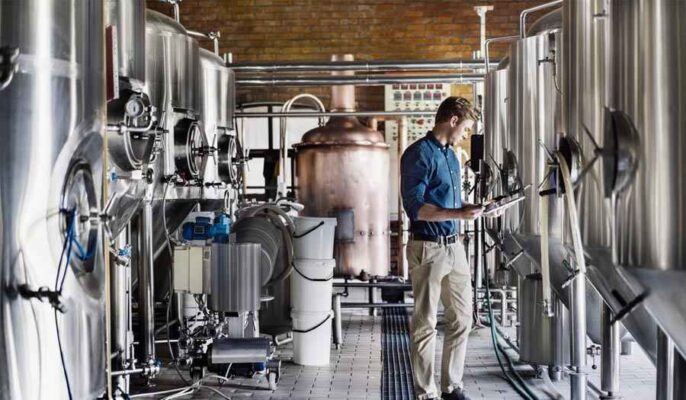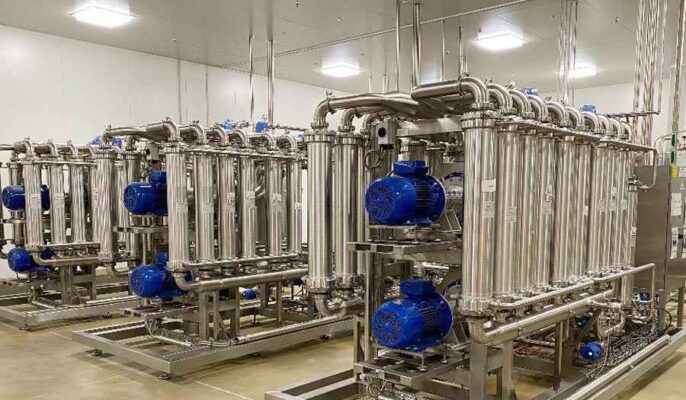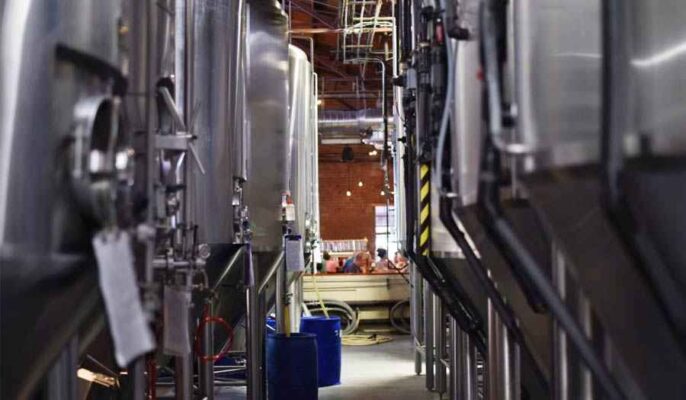Beer brewing is an intricate process that requires specialized large scale beer brewing equipment to produce beer on a commercial scale. For large scale beer production, having the right brewing system and components is crucial to efficiently managing the multiple stages of the beer making process. This guide provides a detailed overview of the major equipment needed for large scale brewery operations, their key features, how to select the right equipment, suppliers, installation and maintenance.
Overview of Large Scale Brewing Equipment
The main pieces of large scale beer brewing equipment required for large scale commercial beer production include:
Table 1: Overview of Core Brewing System Components
| Equipment | Description |
|---|---|
| Brew kettle | The brew kettle or brewing vessel is a large tank where the mashing, lautering and wort boiling stages are carried out. Commercial scale brew kettles are made from stainless steel and range from 10 to 30 barrel capacities. |
| Lauter tun | The lauter tun separates the sweet wort from the grain mush after mashing. It contains false bottom screens and collection pipes to drain wort while retaining grains. |
| Mash filter | An alternative to the lauter tun, the mash filter provides faster runoff times and better extract efficiency. |
| Wort chiller | A heat exchanger that rapidly cools boiled wort to fermentation temperatures. Plate heat exchangers are commonly used. |
| Fermentation tanks | Stainless steel fermenters ranging from 30 to 120 barrel sizes allow commercial scale fermentation of beer. Closed, chilled and pressurized fermenters help control the process. |
| Bright beer tanks | Also known as serving tanks, they allow sedimentation of yeast after fermentation. Beer is carbonated and clarified here before packaging. |
| Filtration system | Removes haze particles and yeast from beer post-fermentation. Depth and membrane filtration are used for polishing and stabilizing beer. |
| Canning/bottling line | Automated systems to package beer into cans, bottles or kegs. Includes labelers, fillers, crowner, packers and palletizers based on output rate. |
Additional large scale beer brewing equipment like grain handling systems, wort aeration system, CIP tanks, steam generators, compressors, cooling towers and glycol chillers are also part of large scale breweries. Brewery controls and automation systems help integrate tanks, sensors, valves, motors and pumps for streamlined operations.

Types of Brewing Systems
large scale beer brewing equipment can be configured based on brewery requirements:
Table 2: Brewing System Types
| System | Description |
|---|---|
| Traditional brew house | Has separate mash tun and lauter tun for mashing and lautering stages. More manual operation. |
| Brewpub system | Compact brewhouse ideal for microbreweries and brewpubs. Combines a direct-fire brew kettle and single vessel mash/lauter tun. Lower capacities between 1 to 5 barrels. |
| Automated brewhouse | Includes integrated mash filter instead of lauter tun. Removes spent grains continuously. Higher level of automation with advanced process control. |
| Megasystem | High capacity system over 100 barrels featuring multiple kettles and mash filters. Designed for very large scale brewing. |
Key Equipment Characteristics and Parameters
The specifications and configurations of large scale beer brewing equipment affect overall brewhouse efficiency, quality and productivity.
Table 3: Technical Features of Brewing Equipment
| Equipment | Key Characteristics |
|---|---|
| Brew kettle | Material of construction: stainless steel (304, 316L)
Volume capacity: 10 to 600 barrel range Direct fire or steam heated Cone or dish bottom shape Sanitary fittings: ports, valves, sight glasses, agitators |
| Mash tun/Lauter tun | Stainless steel or copper construction
5 to 20 barrel capacities False bottom for filtration Rakes for mixing mash Sparge arms for rinsing |
| Mash filter | Capacity from 25 to 200 barrels
Unlimited runoff rates Automated operation with PLC Self cleaning via CIP |
| Fermentation tanks | Stainless steel sanitary tanks
Sizes from 30 to 600 barrels Jacketed and insulated Cooling system Pressure rated |
| Brite tanks | Stainless steel tanks
Sizes 10 to 120 barrels Stackable configuration Cooling control Mixing system CIP cleaning |
| Filtration | Depth filtration with diatomaceous earth or pads
Polymeric membrane filtration Automated backflushing Sterilization in place |
| Canning line | Carbon dioxide purging
Seaming technology: extremely tight seam Fillers: volumetric or overflow Capacity: 40 to 450 cans/minute |
large scale beer brewing equipment Applications
The brewing vessels and systems are designed for specific applications in the beer production process:
Table 4: Equipment Usage in Beer Brewing
| Equipment | Application in Brewing Process |
|---|---|
| Mash tun | Mixing crushed malt with hot water to convert starches to sugar and extract flavors. |
| Lauter tun | Separating sweet wort from spent grains. |
| Brew kettle | Boiling wort with hops for aroma, bitterness and preservation. |
| Wort chiller | Rapidly cooling boiled wort to prepare for fermentation. |
| Fermentation tanks | Adding yeast for alcohol fermentation and maturation. |
| Brite tanks | Carbonating, clarifying and conditioning beer before packaging. |
| Filtration system | Removing haze particles and yeast after fermentation. |
| Canning line | Filling beer into cans at high speeds under counterpressure. |
Sizing and Dimensional Requirements
large scale beer brewing equipment appropriately based on production goals and space availability is vital:
Table 5: Size Parameters for Brewing System Components
| Equipment | Key Sizing Considerations |
|---|---|
| Brew house | Height: 21 to 24 ft
Length: 70 to 90 ft Width: 20 to 30 ft Floor space: 2,000 to 5,000 sq ft |
| Brewhouse vessels | Height to diameter ratio: 2:1 to 3:1
3000Future expansion capacity |
| Fermentation tanks | Length to diameter ratio: 2:1 to 3:1
Ceiling height: 16 to 30 ft |
| Serving tanks | Grouped based on beer types
Stacked 2 to 4 high Adequate walkways |
| Packaging area | Length: 40 to 100 ft
Width: 20 to 40 ft Ceiling height: 16 to 24 ft |
Design Standards and Specifications
large scale beer brewing equipment must meet stringent design and construction standards:
Table 6: Technical Design Standards for Brewing Equipment
| Standard | Requirements |
|---|---|
| Materials | Stainless steel grade: 304, 316L
Smooth surfaces Non-toxic, non-absorbent |
| Fabrication | ASME Pressure Vessel Code
Weld overlay on high wear zones Interior buffed and polished to <150 grit |
| Sanitation | Meets 3A hygienic standards
Crevice-free sanitary fittings Easy cleanability |
| Pressure rating | ASME stamped vessels
MAWP: up to 15 psig |
| Automation | Allen-Bradley or Siemens automation systems
SCADA and MES integration |
Suppliers of Large Scale Brewing Equipment
There are large scale beer brewing equipment manufacturers and brewery engineering firms that supply commercial beer brewing systems:
Table 7: Leading Brewing Equipment Suppliers
| Company | Location | Product/Expertise |
|---|---|---|
| Paul Mueller Company | Springfield, MO, USA | Stainless steel brewing tanks and equipment |
| JVNW | Canby, OR, USA | Brewhouse systems, fermentation, brite tanks |
| Premier Stainless Systems | Escondido, CA, USA | Custom stainless brewhouses, tanks |
| Spike Brewing | Clackamas, OR, USA | Electric brew kettles, fermenters, CIP |
| Prospero Equipment | New York, USA | Brewery process engineering |
| Rolec Prozess und Brautechnik | Germany | Mash filters, brewhouses, fermentation |
| GEA Group | Germany | Complete brewery solutions |
| Criveller | Canada | Brewhouse fabrications, fermentation |
Pricing depends on capacity, automation features and customization. Buying complete packaged systems from a single vendor can provide value engineering benefits versus a piecemeal approach.
Installation and Layout Requirements
Proper installation and layout of the large scale beer brewing equipment enables efficient operations:
Table 8: Brewery Equipment Installation Factors
| Consideration | Details |
|---|---|
| Equipment foundations | Reinforced concrete foundations sized for equipment loads |
| Flooring | Sloped to trenches for drainage
Non-slip, acid resistant finish |
| Overhead space | Adequate overhead room for vessels, piping, cranes |
| Service access | Open layout for equipment access
Catwalks and platforms for tanks |
| Utilities | Steam, water, gas, power supply lines |
| Mechanical | Ventilation, cooling systems, compressed air |
| Electrical | Panelboards, disconnect switches, rigid conduit |
| Automation | Touchscreen panels, sensors, network wiring |
The equipment should be laid out logically based on the brewing process flow. Sufficient space is needed for pipe runs, pumps, valves and other hardware.
Operation and Maintenance
To keep large scale beer brewing equipment performing optimally, proper operation and preventive maintenance is required:
Table 9: Operation and Maintenance of Brewing Equipment
| Activity | Frequency |
|---|---|
| Calibration | Calibrate sensors and measurement devices annually |
| Inspection | Daily visual checks for leaks, damage, wear |
| Lubrication | Lubricate pumps, motors, bearings, drives per OEM |
| CIP cycles | Daily automated clean-in-place cleaning |
| Preventive maintenance | Regular PM program per OEM manuals |
| Equipment logs | Record operating parameters, maintenance, issues |
| Staff training | Train teams on procedures and safety |
| Wear parts | Replace seals, gaskets, screens periodically |
| Tank cleaning | Quarterly manual cleaning of fermenters |
Unexpected downtime can be minimized through scheduled maintenance, staff training and availability of spare parts.
Selecting a Brewery Equipment Supplier
Choosing the large scale beer brewing equipment supplier is key to executing a brewery project successfully:
Table 10: How to Select a Brewery Equipment Provider
| Factor | Assessment Criteria |
|---|---|
| Relevant experience | Years of experience building commercial brewhouses |
| Engineering expertise | In-house engineering team for brewhouse design |
| Manufacturing capabilities | Internal fabrication and quality control capabilities |
| Project management | Structured project management methodology |
| Customization | Ability to customize vessels and layouts |
| Automation capabilities | Sophisticated brewhouse automation solutions |
| Installation services | Experienced crews for professional installation |
| Ongoing support | Maintenance contracts and local service presence |
| References | Reputation based on client references and testimonials |
| Financial stability | Stable company with solid financial track record |
Begin initial vetting through requests for information followed by proposal submissions from multiple vendors. Compare capabilities, experience, services and costs. Visit supplier facilities, existing system installations and customer operations.
Advantages of Turnkey Brewing Systems
Purchasing a turnkey brewhouse system can streamline implementation versus a pieced together approach:
Table 11: Benefits of Turnkey Brewing Solutions
| Advantage | Description |
|---|---|
| Single point of responsibility | Accountability and coordination from one equipment supplier |
| Process optimization | Entire system designed to work together efficiently |
| Ease of expansion | Scalable solutions for incremental capacity growth |
| Expertise and support | Leverage vendor engineering and project expertise |
| Cost efficiencies | Lower costs through standardized fabrication |
| Simplified installation | Integrated equipment delivery and placement |
Turnkey systems enable brewers to get operations running faster and optimize the production process.
Limitations of Pre-Engineered Systems
While turnkey brewhouses provide advantages, brewers should be aware of potential drawbacks:
Table 12: Drawbacks of Pre-Engineered Brewing Systems
| Limitation | Description |
|---|---|
| Less customization | Constrained ability to customize vessels and layout |
| Vendor dependence | Locked into one vendor’s equipment standards |
| Upfront costs | Large initial capital expenditure |
| Change management | Adjusting brewing practices to new system parameters |
| Training requirements | Extensive training needed for brewers on new equipment |
| Limited control | Less control over details of system configuration |
Lack of flexibility and customization can make standardized systems less suitable for some breweries.
Cost Analysis of Commercial Brewing Equipment
The total equipment cost of a commercial brewery system is determined by multiple factors:
Table 13: Typical Equipment Cost Factors
| Type | Cost Considerations |
|---|---|
| Base equipment cost | Capacity, material of construction, degree of automation |
| Ancillary equipment | Grain handling, CIP, cooling systems, controls |
| Freight | Cost higher for imported equipment |
| Import duties | Applicable for imported systems |
| Installation | Concrete, mechanical, electrical requirements |
| Engineering | Process engineering costs |
Equipment prices also vary based on the region and market demand dynamics. Typical cost ranges:
Table 14: Sample Pricing Estimates
| Equipment | Indicative Pricing Range |
|---|---|
| 10 barrel brewhouse | $150,000 to $250,000 |
| 50 barrel brewhouse | $700,000 to $1.2 million |
| 100 barrel brewhouse | $1.5 million to $2.5 million |
| 1,000 barrel brewhouse | $5 million to $8 million |
Quoted pricing depends on the project scope and precise capacities. Request formal quotes from vendors.

FAQs
Some frequently asked questions about commercial beer brewing systems:
Q: What are the pros and cons of direct fire versus steam heated kettles?
A: Direct fire kettles allow more precise control and faster heating but need more maintenance. Steam heated kettles are safer and easier to control, but slower heating.
Q: How many fermenters and brite tanks should a brewery have?
A: A typical ratio is 3 fermenters and 2 serving tanks per 1 brewhouse. But optimize based on number of products, packaging and production planning.
Q: Should brewing equipment be bought domestically or imported?
A: Domestic provides better support while imported has lower costs. Choose based on quality, price and relationships.
Q: What degree of automation is optimal for a brewhouse?
A: Balance automation with flexibility. Look for Semi-automated systems with manual over-rides for mashing, wort boiling, cleaning etc.
Q: How much space is needed for a commercial brewhouse?
A: Allow 2,000 to 5,000 sq ft for a 10 to 50 barrel brewhouse system including working space. Scale up accordingly for larger systems.
Q: Should breweries buy used equipment or new?
A: Used equipment costs less but has risks. Inspect carefully for corrosion and damage. New provides reliability and warranty.
Conclusion
Implementing an efficient large scale brewing system requires careful planning and selection of equipment to meet production targets. Following brewing best practices in system design, sourcing from qualified vendors, proper installation and preventive maintenance enables smooth brewery operations at scale. While turnkey systems provide advantages like single source coordination and optimized processes, the limitations around customization should be evaluated. Assessing equipment characteristics, technology, suppliers, costs and installation requirements as outlined in this guide allows brewers to build a brewhouse tailored to their specific brewing needs and goals.





